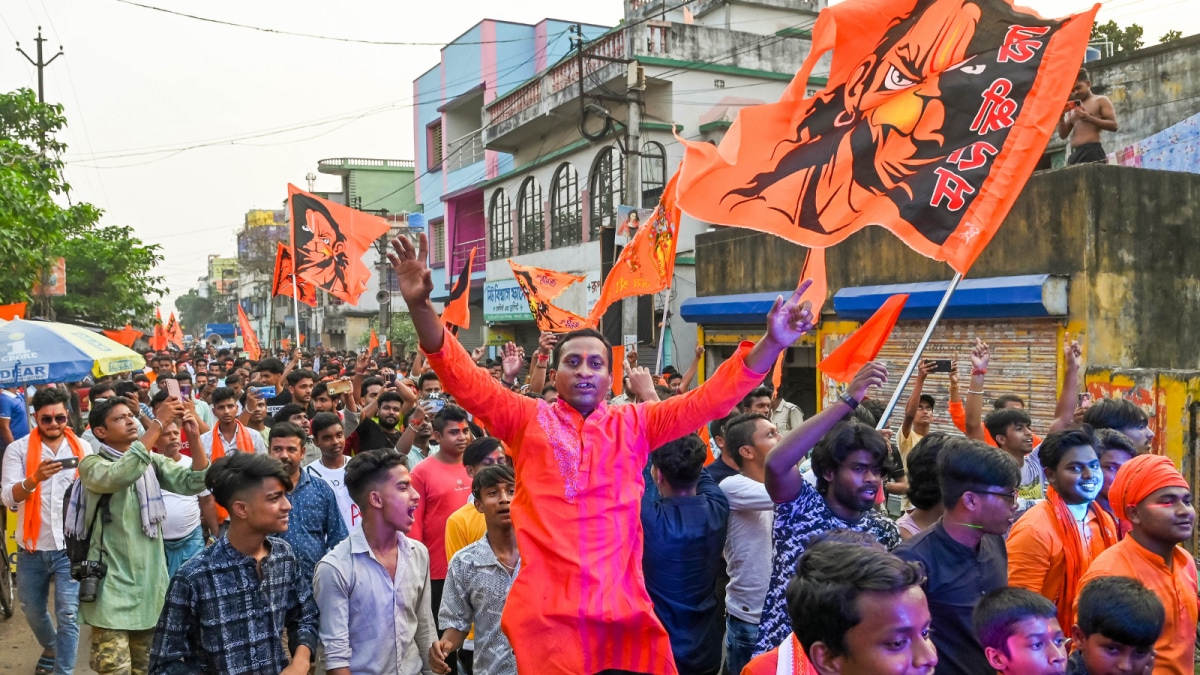Last Updated:
Adding to its significance, April 6 also marks the foundation day of the BJP, commemorating the birth of the party in 1980, with Atal Bihari Vajpayee assuming the mantle of its first President.
Devotees during a procession on the occasion of the ‘Ram Navami’ festival at Ranaghat, in Nadia district of West Bengal in April, last year. (Image: PTI)
April 6 of this year holds significant weight in the realm of West Bengal politics. As the last Ram Navami celebration before the state’s upcoming elections in 2026, it serves as a crucial stage for the intense political battle between the ruling Trinamool Congress (TMC) and the primary opposition, the Bharatiya Janata Party (BJP). Adding to its significance, April 6 also marks the foundation day of the BJP, commemorating the birth of the party in 1980, with Atal Bihari Vajpayee assuming the mantle of its first President. This confluence of events has amplified the importance of April 6, prompting extensive preparations to orchestrate the grandest Ram Navami celebration West Bengal has ever witnessed.
Interestingly, while the Rashtriya Swayamsevak Sangh (RSS) has never spearheaded Ram Navami celebrations in West Bengal, its key affiliates, including the Vishwa Hindu Parishad (VHP), Bajrang Dal, and Durga Bahini, have played a pivotal role in driving numerous successful Ram Navami events across the state in recent years. Their impactful celebrations even prompted the TMC to follow suit.
However, this year marks a departure from tradition, as these Sangh affiliates have been advised to take a step back. This strategic move stems from the desire to avoid the perception of Ram Navami being managed by a select group. Drawing inspiration from the success of the G-20 summit, which witnessed substantial societal participation, the directive encourages a broader, more inclusive approach. The aim is to foster wider mass participation, transcending caste and political affiliations, reflecting the growing discourse surrounding Hindu unity.
In the absence of direct leadership from Sangh outfits, volunteers affiliated with the saffron ecosystem have taken the initiative, forming umbrella organisations like the ‘Jai Shri Ram Committee’ and ‘Ram Navami Udjapan Samiti’ to steer the celebrations. However, the lack of top-down directives has resulted in a degree of ambiguity regarding the celebration’s direction.
DJ, LORD RAM IDOL WITH LED, RATHS ET AL
Within Kolkata, known for its sophisticated urban populace, many of whom are yet to fully embrace the annual religious extravaganza, the celebrations are poised to be grand yet restrained. The city will resonate with the sounds of open cymbals and the iconic ‘Dhak’ drum, an indispensable element of Durga Puja festivities. Long processions will wind through the city, led by individuals adorned in saffron, with saffron flags fluttering prominently.
Venturing beyond Kolkata’s boundaries reveals a different picture, where Ram Navami celebrations are being planned with unprecedented zeal. Organisers report an overwhelming demand for multiple DJs across major subdivisions, particularly in areas like Barasat, Kharagpur, and Birbhum. This surge in enthusiasm has sparked a sense of competition, with organisers vying to outdo each other in terms of procession length and grandeur.
The preparations extend beyond just music, with plans to illuminate roads leading up to the event and incorporate LED-lit idols of Lord Ram into the processions. Some organisers are opting for traditional chariots, from which flower petals will be showered upon the crowds.
‘HINDU UNITY’ AHEAD OF BENGAL POLL?
This year’s Ram Navami arrives at a sensitive juncture in West Bengal’s political landscape. The BJP has alleged a series of temple desecrations, a claim vehemently denied by the ruling TMC. Bengal Chief Minister Mamata Banerjee’s comparison between ‘Maha Kumbh’ and ‘Mrityu Kumbh’ further fueled the fire, prompting the Bengal BJP to accuse her government of appeasement. With an estimated 20,000 Ram Navami events anticipated across Bengal, according to Leader of Opposition Suvendu Adhikari, the BJP aims to leverage the occasion to propagate a message of ‘Hindu Unity’ in the lead-up to next year’s assembly elections.
However, Trinamool Congress’s Parliamentary Affairs Minister, Sobhondeb Chattopadhyay, views these developments as a calculated attempt at polarisation. “When there is failure everywhere, a party does not have anything else, they play the religion card. BJP is now playing the religion card and resorting to religious polarisation. We have grown up here and never seen such hue and cry over Ram Navami,” Chattopadhyay said.
Suvendu Adhikari, on the other hand, remains resolute in his objective: to generate a saffron wave this Ram Navami, a perceived necessity for the BJP’s path to victory in the 2026 elections. “The situation in the state will be similar to that of Bangladesh if Mamata Banerjee remains in power. The days of her rule are numbered. Hindus will not accept her blatant appeasement of one community and attempts to crush Ram Navami celebrations anymore,” Adhikari said.





